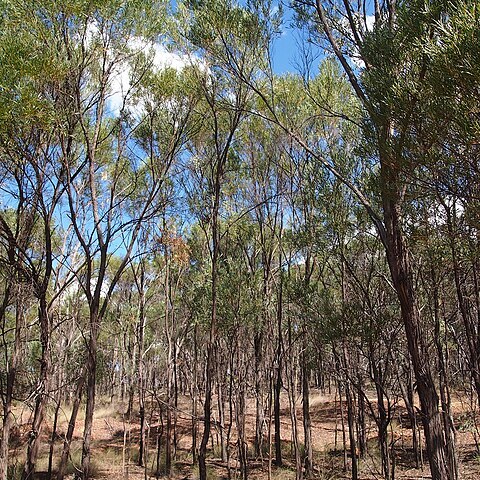Tree to 15 m high, single-stemmed, umbrella-shaped, sometimes a shrub. Bark almost stringy, dark grey to black. Branchlets angular, light brown or yellowish brown, sometimes pruinose, glabrous, resinous or mealy. Phyllodes linear, ± straight or shallowly curved, flat, 8–19 cm long, 2–11 mm wide, coriaceous, slightly pruinose or sometimes partly brownish tinged, glabrous, with subprominent midvein; minor veins 7 or 8 per mm, inconspicuous, parallel, not anastomosing; gland 1, rudimentary, basal. Spikes 1.5–5 (–6) cm long, ± interrupted, lemon-yellow. Flowers 5-merous; calyx 0.5–0.8 mm long, dissected to 1/5–1/4, densely hirsute; corolla 1.5–1.9 mm long, dissected to 1/2, glabrous; ovary densely pubescent. Pods linear, constricted between and raised over seeds, straight to shallowly curved, 6–12 cm long, 3–5 mm wide, crustaceous and rather brittle, longitudinally wrinkled, glabrous. Seeds longitudinal, broadly elliptic, 4–5.5 mm long, black; pleurogram without halo; areole open.
More
A tree. It grows 15 m high. The bark is furrowed. The leaves (phyllodes) are thick and 15 cm long. The tips curve back. The flowers are bright yellow rods. The pods are 12 cm long and straight. They are wrinkled and slightly constricted between the seeds.
Often found in dense stands, also in closed forests, low open forests or mixed savannah woodlands, in shallow gravelly or skeletal sandy soils on sandstone or laterite; at elevations from 50-350 metres.
More
Grows often in dense stands, also in closed forests, low open forests or mixed savannah woodlands, in shallow gravelly or skeletal sandy soils on sandstone or laterite.
It is a tropical plant. It grows in shallow gravelly soils. It suits a well-drained sunny position.


